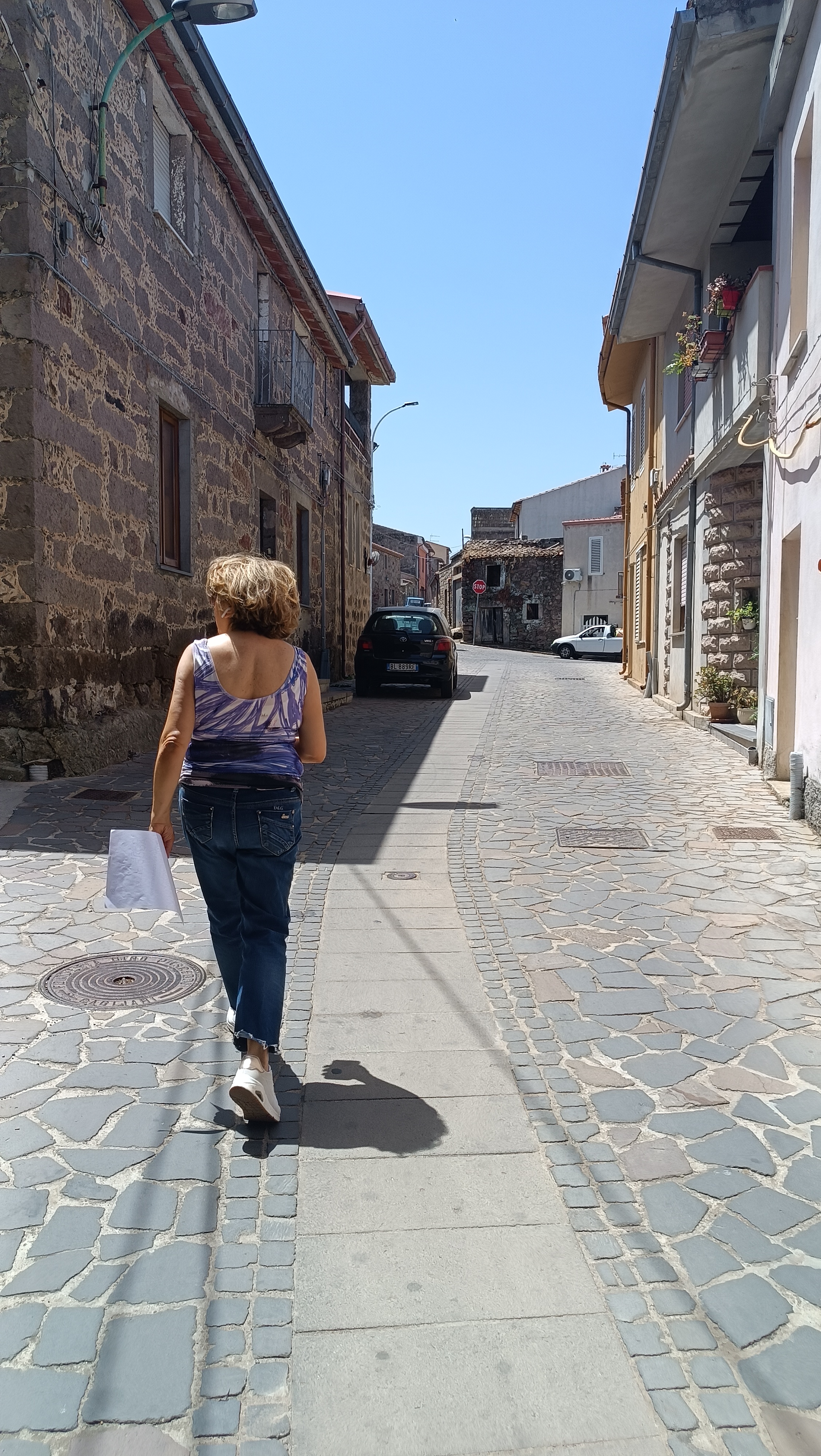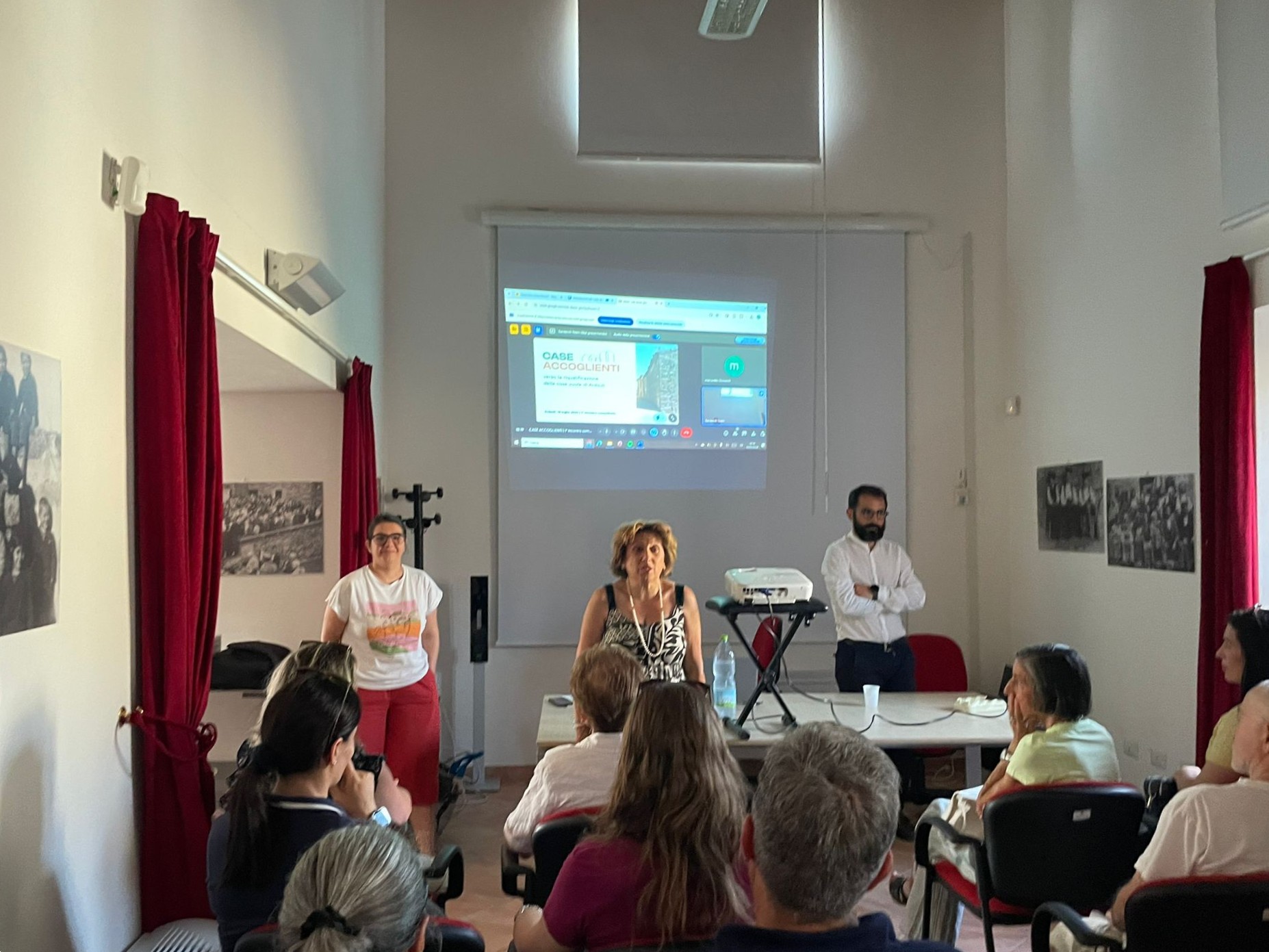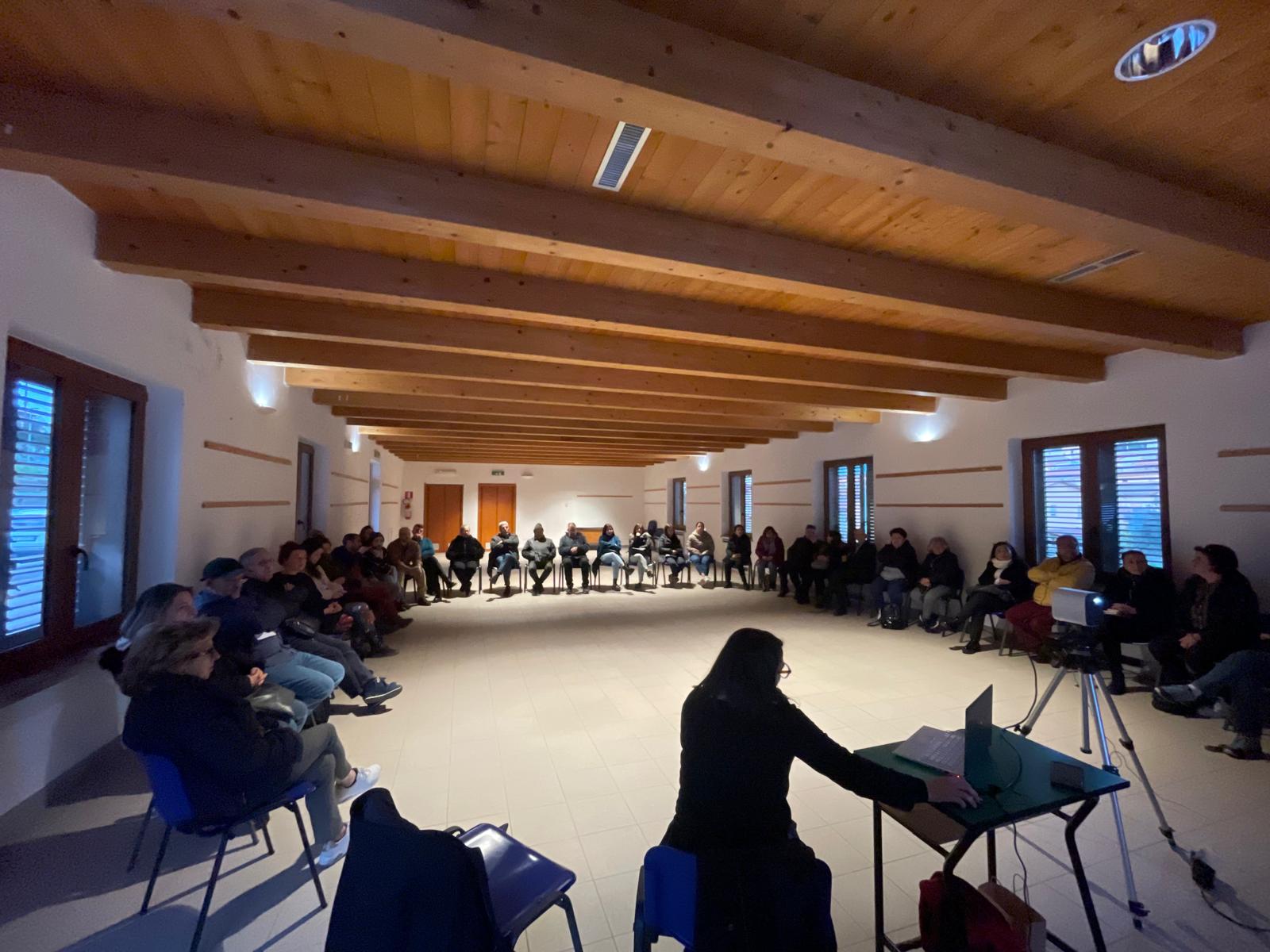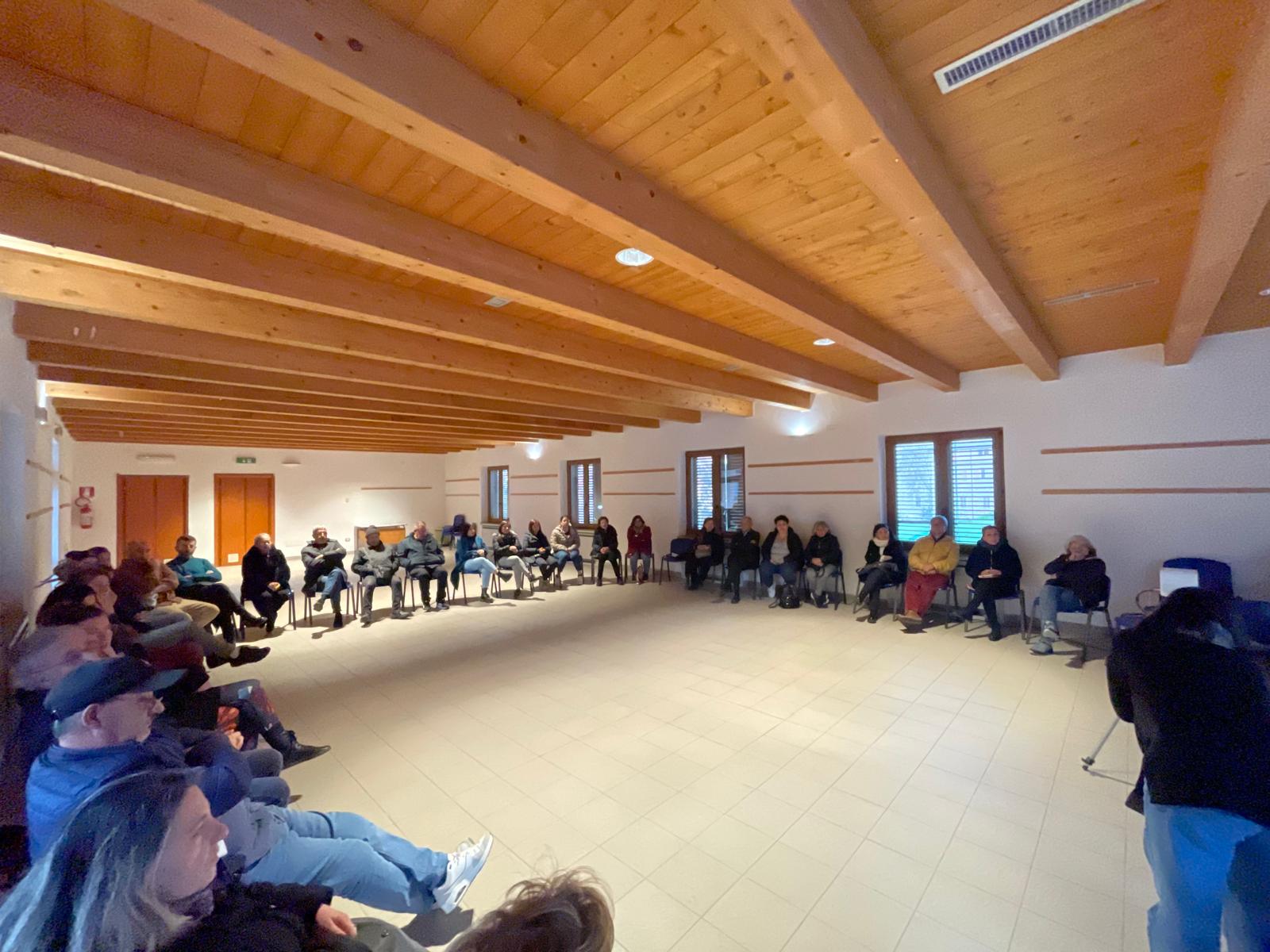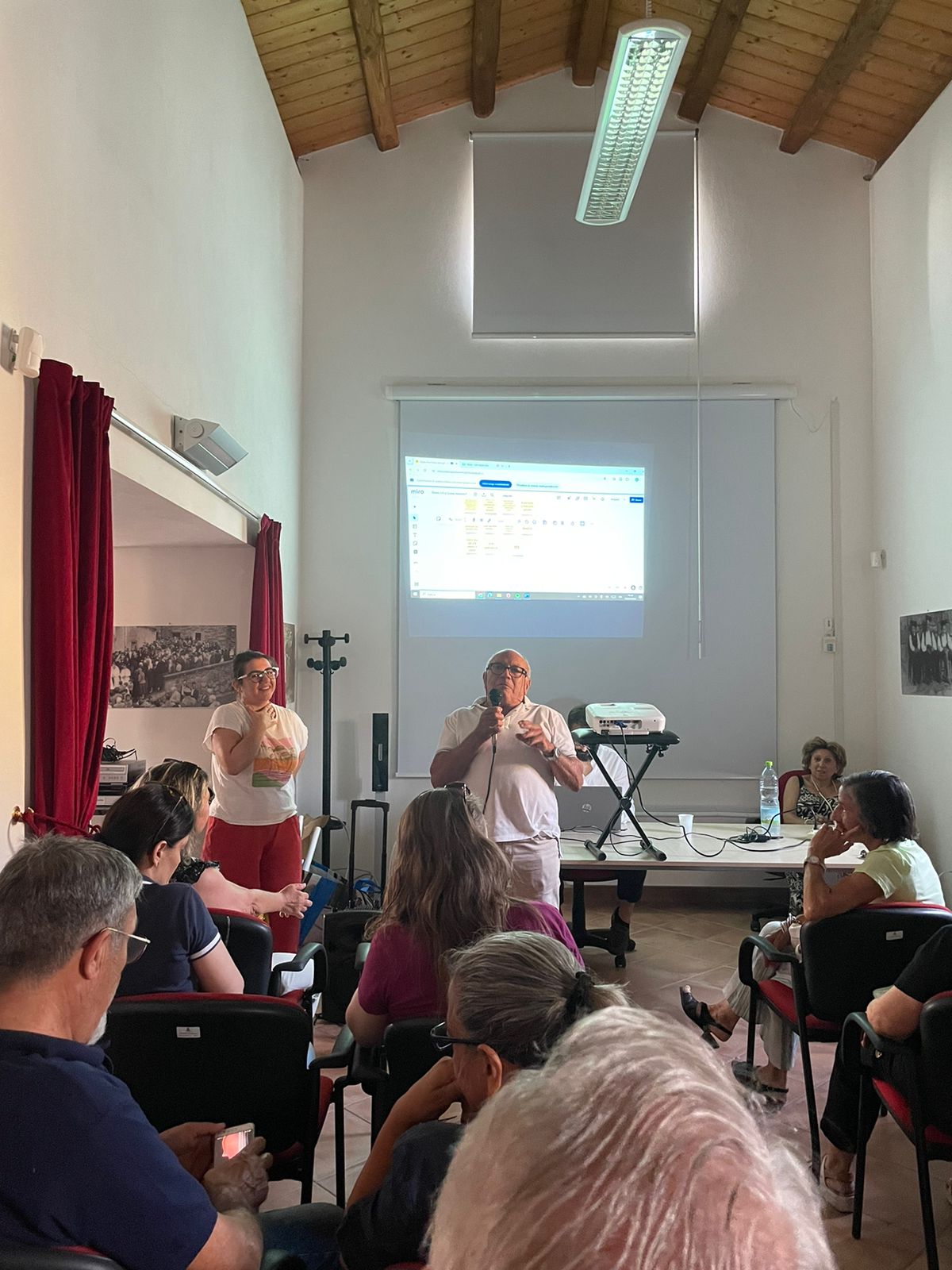Case Accoglienti | Welcoming Homes
{Empty}
Case Accoglienti is a project...
Italy
{Empty}
Prototype level
Yes
Yes
Yes
No
No
095007: Ardauli (IT)
The project “Case Accoglienti | Reviving Ardauli - Workshop for the Urban Regeneration of Ardauli” is an initiative promoted by the Municipality of Ardauli with the support of the Sardarch Cooperative Society, a spin-off of the University of Cagliari. Case Accoglienti means "welcoming homes" in Italian, and its primary goal is to co-design a strategic plan with the Ardaulese community for the regeneration of abandoned real estate in the town and start implementing the process through a pilot action restoring a donated vacant property into the first “Casa Accogliente.” A secondary goal is to strengthen the sense of community among not only permanent residents, but all the people who feel connected to Ardauli, such as emigrants, temporary visitors, and others with ties to the town. The project also benefits residents from the Barigadu region.
Key activities include context research and analysis with stakeholder mapping and engagement, mapping vacant properties and assessing their condition using QGis and QField, identifying available properties through a public call to owners, and carrying out a participatory process to gather community input on regeneration, which will be summarized in the “Case Accoglienti Manifesto” and in a regeneration strategic plan for the Ardauli administration. At least one pilot action will be implemented, with the restoration of the first “Casa Accogliente” as a demonstration of repurposing vacant homes and building trust in the town's transformation.
Expected results include the creation of a QGis database of abandoned properties (ongoing), a participatory design process with at least three meetings to define a reuse strategy (achieved), and the light restoration of the first “Casa Accogliente,” which will become an intergenerational community hub and tourist information office.
Key activities include context research and analysis with stakeholder mapping and engagement, mapping vacant properties and assessing their condition using QGis and QField, identifying available properties through a public call to owners, and carrying out a participatory process to gather community input on regeneration, which will be summarized in the “Case Accoglienti Manifesto” and in a regeneration strategic plan for the Ardauli administration. At least one pilot action will be implemented, with the restoration of the first “Casa Accogliente” as a demonstration of repurposing vacant homes and building trust in the town's transformation.
Expected results include the creation of a QGis database of abandoned properties (ongoing), a participatory design process with at least three meetings to define a reuse strategy (achieved), and the light restoration of the first “Casa Accogliente,” which will become an intergenerational community hub and tourist information office.
urban regeneration
community empowerment
participatory architecture
rural innovation
youth activation
The "Case Accoglienti | Reviving Ardauli" initiative prioritizes sustainability through integrating resource efficiency, adaptive reuse, and environmental resilience in regenerating Ardauli’s built environment. The project focuses on repurposing abandoned real estate and restoring built and open underutilized spaces as part of a broader strategy to combat urban decline. A primary objective is repurposing vacant buildings, minimizing the need for new construction and its associated environmental impacts.
With the light restoration of the first "Casa Accogliente," the project demonstrates how abandoned properties can be regenerated to serve community needs, reducing material waste and promoting energy efficiency. Sustainable building practices, alongside using local materials, further contribute to this goal, ensuring that the regeneration process remains ecologically responsible.
Throughout the project, low-impact practices will be implemented to reduce its ecological footprint, including minimizing the use of printed materials in favor of digital and recycled resources. Additionally, the initiative will offset its carbon emissions by planting trees and creating new green spaces within Ardauli. These measures help mitigate the project’s environmental impact enhance the town's landscape, and support local biodiversity.
The adaptive reuse approach taken in this initiative exemplifies how sustainable urban regeneration can breathe new life into communities. By repurposing vacant properties, the project fosters a sense of belonging and continuity, reinforcing the town's heritage while promoting long-term ecological resilience. This transformation underscores the importance of sustainable urban regeneration in preserving resources, reducing waste, and creating a harmonious relationship between people and the environment.
With the light restoration of the first "Casa Accogliente," the project demonstrates how abandoned properties can be regenerated to serve community needs, reducing material waste and promoting energy efficiency. Sustainable building practices, alongside using local materials, further contribute to this goal, ensuring that the regeneration process remains ecologically responsible.
Throughout the project, low-impact practices will be implemented to reduce its ecological footprint, including minimizing the use of printed materials in favor of digital and recycled resources. Additionally, the initiative will offset its carbon emissions by planting trees and creating new green spaces within Ardauli. These measures help mitigate the project’s environmental impact enhance the town's landscape, and support local biodiversity.
The adaptive reuse approach taken in this initiative exemplifies how sustainable urban regeneration can breathe new life into communities. By repurposing vacant properties, the project fosters a sense of belonging and continuity, reinforcing the town's heritage while promoting long-term ecological resilience. This transformation underscores the importance of sustainable urban regeneration in preserving resources, reducing waste, and creating a harmonious relationship between people and the environment.
Aesthetics is central to the “Case Accoglienti | Reviving Ardauli” project, which seeks to co-design with the community the regeneration of abandoned historical buildings, restore their original beauty, and reconnect the community with its heritage.
A key goal is to engage the people of Ardauli in transforming vacant properties into welcoming spaces that celebrate and share the town’s architectural legacy, including Aragonese portals, finely crafted pink trachyte stone facades, and traditional Sardinian building techniques. The first identified "Casa Accogliente" is located in the town’s oldest district, near the main church. Its light restoration will preserve the distinctive features of the building while incorporating contemporary design elements that enhance both functionality and aesthetic appeal. Carefully integrating spatial design, natural materials, and local craftsmanship will create a beautiful and meaningful space that reflects the community's values.
This initiative also strengthens the emotional and cultural connection of the Ardaulese community to its environment. The historic buildings in Ardauli are not just structures; they are links to family histories and local traditions, carrying a sense of collective identity. The first "Casa Accogliente" will also serve as an information point for tourists, directing them to the region’s cultural and natural attractions. This dual function ensures the space benefits both residents and visitors, deepening appreciation for Ardauli’s heritage, local craftsmanship, and surrounding landscape. By co-designing the repurposing of Ardauli’s built environment while honoring its architectural legacy, "Case Accoglienti | Reviving Ardauli" demonstrates how small towns can set a model of participatory design that transforms spaces, strengthen community bonds, and foster a sense of shared responsibility in preserving cultural identity.
A key goal is to engage the people of Ardauli in transforming vacant properties into welcoming spaces that celebrate and share the town’s architectural legacy, including Aragonese portals, finely crafted pink trachyte stone facades, and traditional Sardinian building techniques. The first identified "Casa Accogliente" is located in the town’s oldest district, near the main church. Its light restoration will preserve the distinctive features of the building while incorporating contemporary design elements that enhance both functionality and aesthetic appeal. Carefully integrating spatial design, natural materials, and local craftsmanship will create a beautiful and meaningful space that reflects the community's values.
This initiative also strengthens the emotional and cultural connection of the Ardaulese community to its environment. The historic buildings in Ardauli are not just structures; they are links to family histories and local traditions, carrying a sense of collective identity. The first "Casa Accogliente" will also serve as an information point for tourists, directing them to the region’s cultural and natural attractions. This dual function ensures the space benefits both residents and visitors, deepening appreciation for Ardauli’s heritage, local craftsmanship, and surrounding landscape. By co-designing the repurposing of Ardauli’s built environment while honoring its architectural legacy, "Case Accoglienti | Reviving Ardauli" demonstrates how small towns can set a model of participatory design that transforms spaces, strengthen community bonds, and foster a sense of shared responsibility in preserving cultural identity.
The “Case Accoglienti | Reviving Ardauli” initiative is deeply rooted in the principle of inclusion, striving to include diverse community members, consolidate social ties, and transform governance and participation models. Since the beginning of the project, many tools (questionnaires, interviews, street informal chats, public events) have been used to engage permanent residents of both Ardauli and coming from other villages of Barigadu regions, emigrants, digital nomads, and newcomers, the project fosters a shared sense of belonging that extends beyond physical presence, making Ardauli an open and welcoming place for all.
A key objective of the project is to include a broad range of voices in the co-design process, which has already been achieved. In fact, through participatory workshops, online engagement, and direct involvement of property owners, decision-making was ensured at this time to be accessible and representative. The project also aims to consolidate community ties by transforming abandoned properties into multifunctional spaces that respond to collective needs, strengthening local associations and informal gathering opportunities while promoting shared responsibility in urban regeneration. Therefore, the first "Casa Accogliente" will serve as an intergenerational hub and a tourist office, welcoming different age groups and social backgrounds and reinforcing cohesion and exchange between locals and visitors. In the restoration of the first Casa Accogliente accessibility criteria - both standard and locally set - will be considered to make it accessible to any kind of people.
By including diverse perspectives, consolidating social networks, and transforming governance through participatory design, “Case Accoglienti | Reviving Ardauli” creates a model that can be easily replicated in other small municipalities.
A key objective of the project is to include a broad range of voices in the co-design process, which has already been achieved. In fact, through participatory workshops, online engagement, and direct involvement of property owners, decision-making was ensured at this time to be accessible and representative. The project also aims to consolidate community ties by transforming abandoned properties into multifunctional spaces that respond to collective needs, strengthening local associations and informal gathering opportunities while promoting shared responsibility in urban regeneration. Therefore, the first "Casa Accogliente" will serve as an intergenerational hub and a tourist office, welcoming different age groups and social backgrounds and reinforcing cohesion and exchange between locals and visitors. In the restoration of the first Casa Accogliente accessibility criteria - both standard and locally set - will be considered to make it accessible to any kind of people.
By including diverse perspectives, consolidating social networks, and transforming governance through participatory design, “Case Accoglienti | Reviving Ardauli” creates a model that can be easily replicated in other small municipalities.
The “Case Accoglienti | Reviving Ardauli” initiative is rooted in community participation, ensuring that those affected by or benefiting from the project play a central role in shaping its outcomes. From the beginning, the project engaged the Ardaulese community, which includes not only permanent residents but also emigrants, digital nomads, and future or seasonal inhabitants who feel connected to Ardauli.
The engagement started with a reach-out phase using various tools: an online questionnaire to assess the people’s attachment to Ardauli and measure the sense of community, semi-structured interviews, informal street chats, and, in the third phase, a participatory co-design process that has just concluded. This process occurred both in person and online, allowing those who do not currently live in Ardauli but wish to move there or visit during different seasons to join the conversation. Of course, the Ardaulese community will remain actively involved in implementing the pilot action.
These engagement tools have allowed individuals to share ideas, voice concerns, and actively participate in decision-making. This process helped identify community needs, such as the demand for an intergenerational hub and tourist office, while also strengthening the sense of community and fostering project ownership. Local civil society organizations, businesses, and cultural associations have been essential, offering valuable knowledge and perspectives. Community involvement has been vital for the project’s success so far. Citizens have contributed to mapping vacant properties, identifying spaces suitable for reuse, and envisioning their future purposes. Owner engagement, in particular, has been crucial in encouraging more property owners to consider making their spaces available for revitalization. The project will continue promoting inclusive, shared governance, enabling citizens to co-manage the first “Casa Accogliente.”
The engagement started with a reach-out phase using various tools: an online questionnaire to assess the people’s attachment to Ardauli and measure the sense of community, semi-structured interviews, informal street chats, and, in the third phase, a participatory co-design process that has just concluded. This process occurred both in person and online, allowing those who do not currently live in Ardauli but wish to move there or visit during different seasons to join the conversation. Of course, the Ardaulese community will remain actively involved in implementing the pilot action.
These engagement tools have allowed individuals to share ideas, voice concerns, and actively participate in decision-making. This process helped identify community needs, such as the demand for an intergenerational hub and tourist office, while also strengthening the sense of community and fostering project ownership. Local civil society organizations, businesses, and cultural associations have been essential, offering valuable knowledge and perspectives. Community involvement has been vital for the project’s success so far. Citizens have contributed to mapping vacant properties, identifying spaces suitable for reuse, and envisioning their future purposes. Owner engagement, in particular, has been crucial in encouraging more property owners to consider making their spaces available for revitalization. The project will continue promoting inclusive, shared governance, enabling citizens to co-manage the first “Casa Accogliente.”
The “Case Accoglienti | Reviving Ardauli” initiative has engaged many stakeholders at the local, regional, national, and European levels. Through structured and semi-structured interviews, along with targeted conference calls, the initiative has gathered valuable insights, resources, and commitments from various actors, all of whom play a significant role in the project. Locally, the Municipality of Ardauli, supported by the Sardarch Cooperative Society, has led the initiative in close collaboration with residents, property owners, and local associations. The participatory process has actively involved the entire Ardaulese community, including permanent residents, local association representatives, emigrants, and seasonal inhabitants, as well as those planning to relocate to Ardauli.
Additionally, the initiative has welcomed participation from people in the surrounding Barigadu region, who are linked to Ardauli through work, family, or curiosity. Through community meetings and interviews, we gathered their perspectives on local needs and potential uses for abandoned spaces.
At the regional level, Sardarch Cooperative Society, a spin-off from the University of Cagliari, has provided expertise in participatory urban regeneration. Social researchers, architects, and urban planners have conducted in-depth interviews with key stakeholders to identify the challenges of housing abandonment and explore strategies for repurposing these spaces.
The Sardinians Association Network has provided crucial support nationally and across Europe. With members throughout Italy and Europe, the network helps promote the initiative and communicates its goals to potential participants.
This multi-level engagement ensures the project is deeply grounded in local needs while benefiting from broader expertise and policy frameworks. It also sets a model for other small municipalities facing similar challenges.
Additionally, the initiative has welcomed participation from people in the surrounding Barigadu region, who are linked to Ardauli through work, family, or curiosity. Through community meetings and interviews, we gathered their perspectives on local needs and potential uses for abandoned spaces.
At the regional level, Sardarch Cooperative Society, a spin-off from the University of Cagliari, has provided expertise in participatory urban regeneration. Social researchers, architects, and urban planners have conducted in-depth interviews with key stakeholders to identify the challenges of housing abandonment and explore strategies for repurposing these spaces.
The Sardinians Association Network has provided crucial support nationally and across Europe. With members throughout Italy and Europe, the network helps promote the initiative and communicates its goals to potential participants.
This multi-level engagement ensures the project is deeply grounded in local needs while benefiting from broader expertise and policy frameworks. It also sets a model for other small municipalities facing similar challenges.
The “Case Accoglienti | Reviving Ardauli” project is built on an interdisciplinary approach that combines urban planning, architecture, social sciences, and service design. This cross-disciplinary collaboration, led by Sardarch, a research-driven cooperative specializing in participatory urban regeneration, has allowed different fields to interact and contribute unique perspectives. Integrating expertise from multiple domains ensures that the regeneration of abandoned spaces is both strategic and community-driven. Urban planning has been an essential discipline in mapping Ardauli’s built and abandoned heritage, analyzing spatial patterns, and identifying opportunities for reuse. Through tools like QGIS and QFIELD and data collected through the public call to property owners, planners have assessed the distribution and condition of vacant properties, laying the groundwork for informed decision-making. Architects specializing in historic restoration will focus on restoring selected buildings, preserving Ardauli’s distinctive heritage, including Aragonese portals and pink trachyte stone facades, while adapting spaces for contemporary use.
The social science field was also essential and has contributed to understanding community dynamics, depopulation challenges, and the evolving needs of residents, emigrants, and temporary vi A sociologist has carried the context research and analysis through a focus group, questionnaire, and semi-structured interviews and the reach out and engagement activities. Service design has played a crucial role in being the approach adopted throughout the whole project especially in the participatory process and the meeting point of all the above fields. Urban planners, architects, and sociologists have jointly facilitated the co-designing activities with the community, collecting people's needs and new uses for restored buildings and transforming them into multifunctional spaces that enhance cultural, social, and touristic opportunities.
The social science field was also essential and has contributed to understanding community dynamics, depopulation challenges, and the evolving needs of residents, emigrants, and temporary vi A sociologist has carried the context research and analysis through a focus group, questionnaire, and semi-structured interviews and the reach out and engagement activities. Service design has played a crucial role in being the approach adopted throughout the whole project especially in the participatory process and the meeting point of all the above fields. Urban planners, architects, and sociologists have jointly facilitated the co-designing activities with the community, collecting people's needs and new uses for restored buildings and transforming them into multifunctional spaces that enhance cultural, social, and touristic opportunities.
The “Case Accoglienti | Reviving Ardauli” initiative is a groundbreaking model in Sardinia and Italy. No other public administration strategically plans the regeneration of historic centers through a participatory approach. While most municipalities focus on isolated restorations or specific call-based incentives, Ardauli is pioneering a comprehensive, community-driven process involving residents in shaping the town’s future.
Moreover, unlike traditional top-down interventions, this initiative involve the whole Ardulese community, which is not just made of permanent residents, but also temporary residents, emigrants, digital nomads and so on. Through qualitative and quantitative social research tools, semi-structured interviews, public calls, and co-design workshops using the service design approach, the current project wants actions to align with real needs rather than external assumptions, fostering local engagement and trust.
Rather than focusing solely on heritage restoration, "Case Accoglienti" integrates service design principles to create multifunctional spaces that transform abandoned buildings into valuable community assets, as it is the case of the first "Casa Accogliente", a historic home in the oldest part of Ardauli, will be repurposed as an intergenerational community hub and tourist information center, responding to both local and visitor needs, as emerged from the participatory process.
Moreover, unlike traditional top-down interventions, this initiative involve the whole Ardulese community, which is not just made of permanent residents, but also temporary residents, emigrants, digital nomads and so on. Through qualitative and quantitative social research tools, semi-structured interviews, public calls, and co-design workshops using the service design approach, the current project wants actions to align with real needs rather than external assumptions, fostering local engagement and trust.
Rather than focusing solely on heritage restoration, "Case Accoglienti" integrates service design principles to create multifunctional spaces that transform abandoned buildings into valuable community assets, as it is the case of the first "Casa Accogliente", a historic home in the oldest part of Ardauli, will be repurposed as an intergenerational community hub and tourist information center, responding to both local and visitor needs, as emerged from the participatory process.
The “Case Accoglienti | Reviving Ardauli” initiative combines a research-action approach with service design methodology, ensuring a user-centered, interdisciplinary, and iterative process. This approach moves beyond traditional urban regeneration models by actively involving the community in every stage, from needs assessment to implementation.
Service design is a user-oriented practice that integrates design, management, and process engineering to create services that respond effectively to people’s needs. It is based on several key concepts:
Service is understood as the interaction between users and a system of activities designed to improve their experience.
Users include both permanent and temporary residents, as well as visitors benefiting from revitalized spaces.
Touchpoints are the moments of interaction between users and the service, such as community workshops, digital platforms, or the physical space of the Casa Accogliente.
Tools include participatory design activities, mapping techniques, and iterative testing methods that guide the initiative's evolution.
The process follows key principles such as user orientation, co-creation, sequentiality, tangibility, a holistic approach, and iterativity. The iterative cycle, prototyping, testing, analysis, and refinement, ensures the design remains flexible and responsive to community needs. Open processes engage stakeholders at different levels, allowing for continuous feedback and aligning interventions with local expectations.
Through this methodology, “Case Accoglienti” not only restores abandoned buildings and transforms them into meaningful public spaces tailored to the needs of Ardauli’s citizens.
Service design is a user-oriented practice that integrates design, management, and process engineering to create services that respond effectively to people’s needs. It is based on several key concepts:
Service is understood as the interaction between users and a system of activities designed to improve their experience.
Users include both permanent and temporary residents, as well as visitors benefiting from revitalized spaces.
Touchpoints are the moments of interaction between users and the service, such as community workshops, digital platforms, or the physical space of the Casa Accogliente.
Tools include participatory design activities, mapping techniques, and iterative testing methods that guide the initiative's evolution.
The process follows key principles such as user orientation, co-creation, sequentiality, tangibility, a holistic approach, and iterativity. The iterative cycle, prototyping, testing, analysis, and refinement, ensures the design remains flexible and responsive to community needs. Open processes engage stakeholders at different levels, allowing for continuous feedback and aligning interventions with local expectations.
Through this methodology, “Case Accoglienti” not only restores abandoned buildings and transforms them into meaningful public spaces tailored to the needs of Ardauli’s citizens.
This initiative presents a replicable and transferable model for small municipalities facing challenges such as depopulation, abandoned real estate, and the need for community-driven regeneration. Based on research-action and service design, the methodology can be adapted by other local administrations, associations, or stakeholder groups aiming to activate underutilized spaces through participatory approaches.
Potential replicable elements are:
- Participatory mapping and community engagement
Identifying and mapping abandoned properties through public involvement can be easily replicated. By combining digital tools (such as QField and others) with face-to-face engagement, municipalities can create comprehensive inventories of vacant spaces to plan strategic interventions.
- Co-design and iterative prototyping
The service design methodology, emphasizing user-oriented solutions, co-creation, and iterative processes, is highly adaptable. Other communities can apply this model to test, refine, and implement regeneration strategies that best fit their local needs.
- Strategic planning for historic centers
Unlike many public administrations in Sardinia and Italu, this project has strategically planned the regeneration of its historic center rather than approaching it through isolated, case-by-case interventions. This structured yet flexible strategy can be transferred to other municipalities looking for long-term solutions.
- Pilot Actions as a trust-building strategy
Demonstrating success through small-scale interventions, such as the first Casa Accogliente serving as a community hub and info point, can effectively build trust and momentum in communities skeptical of change. This strategy can be applied in various urban and rural contexts.
By transferring these elements, the project serves as a model for municipalities across Sardinia, Italy, and Europe, proving that even small communities can lead innovative, inclusive, and sustainable regeneration processes.
Potential replicable elements are:
- Participatory mapping and community engagement
Identifying and mapping abandoned properties through public involvement can be easily replicated. By combining digital tools (such as QField and others) with face-to-face engagement, municipalities can create comprehensive inventories of vacant spaces to plan strategic interventions.
- Co-design and iterative prototyping
The service design methodology, emphasizing user-oriented solutions, co-creation, and iterative processes, is highly adaptable. Other communities can apply this model to test, refine, and implement regeneration strategies that best fit their local needs.
- Strategic planning for historic centers
Unlike many public administrations in Sardinia and Italu, this project has strategically planned the regeneration of its historic center rather than approaching it through isolated, case-by-case interventions. This structured yet flexible strategy can be transferred to other municipalities looking for long-term solutions.
- Pilot Actions as a trust-building strategy
Demonstrating success through small-scale interventions, such as the first Casa Accogliente serving as a community hub and info point, can effectively build trust and momentum in communities skeptical of change. This strategy can be applied in various urban and rural contexts.
By transferring these elements, the project serves as a model for municipalities across Sardinia, Italy, and Europe, proving that even small communities can lead innovative, inclusive, and sustainable regeneration processes.
This initiative addresses global challenges such as depopulation, the abandonment of historic centers, and the loss of cultural heritage, particularly in rural areas. Many small towns worldwide face population decline, leaving behind vacant homes and deteriorating public spaces. This project offers a local solution by repurposing abandoned buildings, demonstrating that historic centers can be reactivated as vibrant places for living, working, and socializing. By focusing on adaptive reuse, the initiative not only combats depopulation but also contributes to the preservation of cultural heritage, ensuring that Ardauli’s unique architectural identity remains intact. The project engages the local community, including residents, emigrants, and temporary visitors, through a participatory approach that involves them in the decision-making process. This ensures that solutions are tailored to the needs of the people who live in, or have ties to, the town, strengthening social bonds and fostering a sense of ownership. It contrasts with top-down urban regeneration strategies that often overlook the people most affected by changes, instead empowering them to co-design the town’s future. The initiative also addresses the economic challenges posed by vacant properties. Rather than relying on new construction, the project repurposes existing buildings, aligning with circular economy principles by reducing waste and maximizing the use of local materials. This approach supports local stakeholders and tourism, creating new economic opportunities while enhancing the town’s appeal. In summary, this initiative provides a sustainable, locally driven response to global challenges, demonstrating how small municipalities can use innovative, community-focused strategies to regenerate historic centers, preserve cultural heritage, and foster economic growth.
The "Case Accoglienti | Reviving Ardauli" initiative embraces the New European Bauhaus (NEB) values of sustainability, inclusivity, and aesthetics, engaging the community at every stage. The project is divided into five phases, each incorporating NEB principles.
Phase 1 (April - July 2024) focuses on community engagement and context analysis. This participatory approach brings together permanent residents, but also emigrants, and temporary visitors to ensure their needs are heard and addressed. An online and offline campaign, including the Ardaulese diaspora, raises awareness, while a public event fosters resident engagement.
In Phase 2 (August - December 2024), the focus shifts to mapping vacant properties using modern technologies like QField and QGIS, alongside a public call for community participation. This phase ensures transparency and collective ownership, aligning with NEB's goal of making urban spaces more attractive and functional.
Phase 3 (January - February 2025) continues the participatory process through three meetings, gathering ideas for repurposing available properties. The community’s input informs the creation of the "Manifesto of Case Accoglienti" by Sardarch, emphasizing human-centered design and social cohesion.
Phase 4 (March - July 2025) will implement the first “Casa Accogliente,” demonstrating a commitment to sustainability with light renovation techniques and community involvement. Workshops and participatory architecture empower locals to restore their heritage, enriching the town’s aesthetic and cultural value.
Finally, Phase 5 (August 2025) will celebrate the project’s success with a community event, strengthening the sense of responsibility and ownership. The results will be disseminated, showcasing the completed “Casa Accogliente,” ensuring long-term impact and setting a model for future regeneration efforts.
Phase 1 (April - July 2024) focuses on community engagement and context analysis. This participatory approach brings together permanent residents, but also emigrants, and temporary visitors to ensure their needs are heard and addressed. An online and offline campaign, including the Ardaulese diaspora, raises awareness, while a public event fosters resident engagement.
In Phase 2 (August - December 2024), the focus shifts to mapping vacant properties using modern technologies like QField and QGIS, alongside a public call for community participation. This phase ensures transparency and collective ownership, aligning with NEB's goal of making urban spaces more attractive and functional.
Phase 3 (January - February 2025) continues the participatory process through three meetings, gathering ideas for repurposing available properties. The community’s input informs the creation of the "Manifesto of Case Accoglienti" by Sardarch, emphasizing human-centered design and social cohesion.
Phase 4 (March - July 2025) will implement the first “Casa Accogliente,” demonstrating a commitment to sustainability with light renovation techniques and community involvement. Workshops and participatory architecture empower locals to restore their heritage, enriching the town’s aesthetic and cultural value.
Finally, Phase 5 (August 2025) will celebrate the project’s success with a community event, strengthening the sense of responsibility and ownership. The results will be disseminated, showcasing the completed “Casa Accogliente,” ensuring long-term impact and setting a model for future regeneration efforts.

